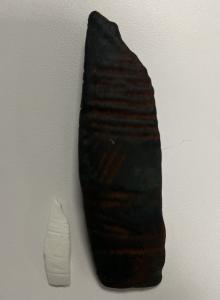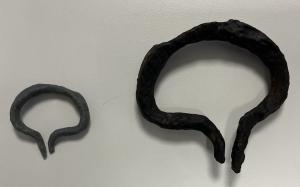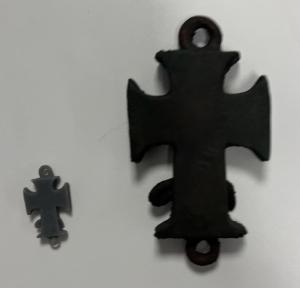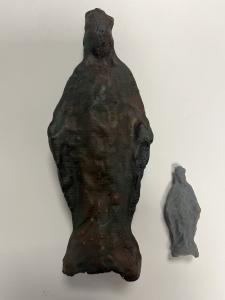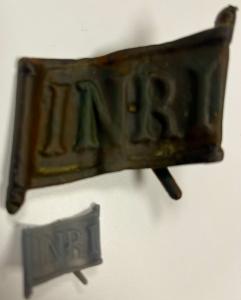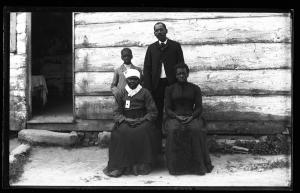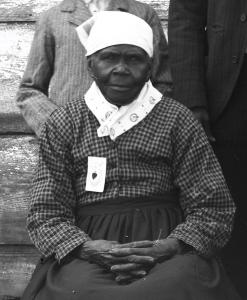From the arrival of Jesuits in Maryland in 1633, the sites of their missions were inextricably intertwined with the tobacco plantations and slavery that financed their work. Compelling evidence of the cultural impact of these endeavors lies underground. Archaeologists have uncovered artifacts at St. Inigoes and near White Marsh that suggest the Jesuits’ impact on the culture of Native Americans, enslaved and free people of African descent, indentured servants, and tenant farmers through the twentieth century.
This exhibition complements "Facing Georgetown's History through Art," April 11-October 15, 2024.
Smoking Pipe Bowl
Jane Beeler (SFS ‘25)
2023
3D print of terracotta pipe fragment recovered at Old Chapel Field, St. Inigoes Plantation
The presence of tobacco pipes at the earliest Jesuit settlement at Old Chapel Field suggests the prevalence of tobacco production and consumption as early as 1660. Indigenous people of the Potomac region engaged in this commerce, as they made pipes using terra cotta, the material of this pipe fragment.
Mouth Harp
Jane Beeler (SFS ‘25)
2023
3D print of iron alloy musical instrument recovered at Old Chapel Field, St. Inigoes Plantation
Europeans brought this mouth harp to the earliest of the Jesuit settlements. A popular instrument throughout Europe, a mouth harp was an accessible form of entertainment. Musicians placed it in their mouths and produced notes by moving their tongues and altering the shape of their mouths.
Reliquary in the Form of a Cross
Jane Beeler (SFS ‘25)
2023
3D print of silver hollow cross recovered at Manor House, St. Inigoes Plantation
This silver hollow cross, dating between 1680 and 1750, was found near the manor house used by the Jesuit missionaries of St. Inigoes. Although empty when recovered, the reliquary held tiny parts of the body or clothes of a deceased saint to serve as a memorial. Catholics believed that these relics also provided a spiritual link between life and death and had healing powers.
Madonna Figurine
Jane Beeler (SFS ‘25)
2023
3D print of a pewter figurine recovered at Willow Grove Plantation, Prince George’s County
Used in private prayers directed to the person of Mary, mother of Jesus Christ, this pewter figurine was found in a dwelling used by Black tenant farmers after emancipation at Willow Grove Plantation. Free black laborers and tenant farmers regularly walked from this plantation to Sacred Heart Church, part of the Jesuit community of White Marsh near Bowie, so this figurine was likely used in their private devotions.
Crucifix Plaque
Jane Beeler (SFS ‘25)
2023
3D print of copper alloy plaque recovered at Priest’s Point, St. Inigoes Plantation
This plaque with the abbreviation “INRI” – the Latin phrase “Iesus Nazarenus Rex Iudaeorum” which translates into “Jesus of Nazareth, King of Jews” – was likely affixed to a wooden crucifix in a small house at St. Inigoes plantation occupied by the families of Louisa Mahoney Mason, where she lived with her family from approximately 1850 through 1890, and James Raley, a white tenant farmer who rented the house in the early twentieth century.
Robert Mason and His Family of St. Inigoes, c. 1900
Photograph by John Brosnan, S.J.
Brosnan Photographic Collection
Woodstock Theological Library
Identified by photographer Father John Brosnan – “St. Inigoes - Bob Mason family + our workman” – this photograph portrayed two people formerly enslaved by the Jesuits: Robert Mason (right) and his mother Louisa Mahoney Mason (left) with an unidentified woman and a child. Despite the separation of their family during the 1838 sale, which Louisa and her mother escaped, the Masons dutifully served the Jesuits of St. Inigoes and other communities in Maryland and Pennsylvania.
Louisa Mahoney Mason (detail)
Photograph by John Brosnan, S.J.
Brosnan Photographic Collection
Woodstock Theological Library
The Mason family played a leading role in the celebrations, benevolent associations, and sodalities organized by Black Catholics near St. Inigoes. In this photo, Louisa is wearing a Sodality Badge with an emblem of the Sacred Heart of Jesus.
This online exhibition presents facsimiles of artifacts in actual and enlarged sizes with supporting documentary evidence held by the Booth Family Center for Special Collections. Archaeologists recovered these artifacts at the first site established by the Jesuits at Old Chapel Field, St. Inigoes (active 1660-1680); a site located one-quarter mile south at Old Chapel Field, St. Inigoes (active 1740-1940); and Willow Grove Plantation located near White Marsh (active c. 1790-1970).
Laura Masur, Catholic University Assistant Professor of Anthropology and lead archaeologist at excavations at Jesuit plantations and missions in Southern Maryland, presented her work to “Facing Georgetown’s History,” a class offered by Adam Rothman, Professor of History. They inspired Jane Beeler (SFS ‘25) to use 3D printers in Lauinger Library’s Maker Hub to create reproductions of artifacts excavated by archaeologists at the sites of Jesuit plantations. Beeler selected items from Archaeology of Jesuit-Enslaved Ancestors, a collection of 3D photographic images of artifacts submitted by Professor Masur to the Virtual Curation Laboratory at Virginia Commonwealth University in Richmond. The archaeological objects are preserved by the Department of Anthropology at the Catholic University of America, Naval Air Station Patuxent River Webster Field Annex, and the Maryland Archaeological Conservation Laboratory in Jefferson Park.

